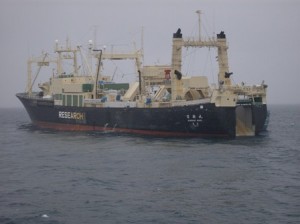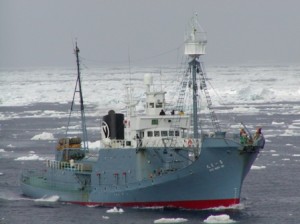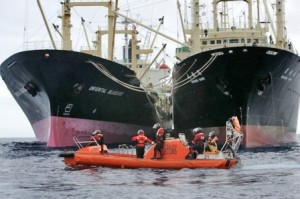The Conference on Biodiversity taking place in Nagoya Japan ends today while, in November, the Japanese whaling fleet will leave for Antarctica to catch 1,000 whales. Since 1986, when the moratorium on commercial whaling entered into force Japan has killed, in the name of science, 13,210 whales of which close to 10,000 were caught in Antarctica, a whale sanctuary since 1994. Considering the state of the Japanese whaling fleet, the entire Antarctic ecosystem is threatened by an oil spill.
The mother-ship, Nisshin Maru, ex Chikuzen Maru was launched in 1987. She was initially a stern trawler in American waters. She was quickly converted into a whaling factory ship. She works in the Antarctic Ocean without a double hull or reinforcement against ice and with only one engine. In February 2007, while the Nisshin Maru was sailing in the Ross Sea, a major explosion occurred aboard killing a crewmember and immobilising the vessel leaving her to drift for several days in the ice-infested Southern Seas. According to New Zealand authorities, the incident is one of the most serious to have occurred in the region. The Japanese did not immediately send out an SOS. The Nisshin Maru is also a little tanker with a capacity of holding 2,600 tons of fuel.
February 2007, the Nisshin Maru after the fire onboard was extinguished
© Institute of Cetacean Research.
As for the rest of the Japanese whaling fleet they are not in a much better state. Marine mammals are localised by two vessel among which the 36 year old Kaiko Maru; they are then harpooned and dragged to the factory-ship by three catchers of which the oldest is the Kyo Maru n°1, 39 years old.
The Kyo Maru is not ice-reinforced contrarily to IMO Guidelines for Ships Operating in Polar Waters
© Institute of Cetacean Research.
All these vessels are flying a Japanese flag. This was not the case of the Oriental Bluebird, a reefer converted into a tanker built in 1979 and operating under a Panamanian flag. She was used as a petrol station by the Japanese whaling fleet in Antarctica. Extraordinarily, in 2008 she was deregistered by Panama for trans-shipment and transport of whale meat and for violation of Panamanian regulations for the protection of marine mammals. Since these events she was renamed Hiyo Maru, and has just been sent for demolition to China. Ship-to-ship refuelling operations generate risks for the environment. Prior to operations it should be subject to an Environmental Impact Assessment in compliance with the protocol on Environmental Protection of the Antarctic Treaty (Article 8 of the Protocol). However, Japan does not care a bit.
January 2008, the Japanese whaling fleet’s factory ship Nisshin Maru as she transfers whale meat and refuels from the supply ship Oriental Bluebird, in Antarctic waters. Australian government customs officials in the foreground.© Reuters
Risks to the Antarctic are increased by the extreme navigation conditions and because of the remoteness of the fleet rescue interventions are difficult or impossible. The only incidents which the Japanese authorities talk about are those related to conflicts with environmental activists opposed to whaling. These field actions as well as diplomatic and legal measures should push Japan to leave its vessels at the port of Shimonoseki in compliance with the Antarctic Treaty. Indeed the preamble of the Antarctic Treaty states that it is in all of mankind’s interest that Antarctica continue forever to be used exclusively for peaceful purposes and shall not become the scene or object of international discord.
During the 5 months of the whaling campaigns the convoy of 6 Japanese vessels consumes at least 5,000 tons of fuel therefore sending 15,000 tons of CO2, sulphur and soot into the relatively pristine atmosphere.
Considering new regulations this could be the last trip for the Nisshin Maru beyond 60° South latitude as it will be prohibited to transport or use heavy fuels in the Antarctica (new amendment to the IMO convention MARPOL).Today the Japanese must choose between quickly their vessels, at great costs, or quickly turning the page of this scientific hoax. Robin des Bois is hoping that the 2 billion dollars offered by the Japanese to developing countries at Nagoya will not be used as a supplementary argument to gather their support and their votes during the International Whaling Commission.
Use of images in any manner contrary to the objective, mandate and direction of the Institute of Cetacean Research is prohibited excepted for journalists and Non-profit organisations supporting sustainable utilisation of wildlife including marine resources. Rational use of natural resources is a part of Robin des Bois’ beliefs.
 Imprimer cet article
Imprimer cet article











